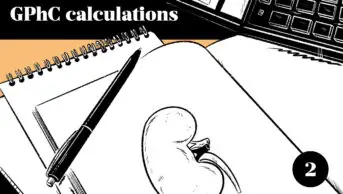
Wes Mountain/The Pharmaceutical Journal
As a professional journal and member publication, The Pharmaceutical Journal aims to provide access to high-quality, expert authored educational resources that support foundation trainees during their training, while revising for the General Pharmaceutical Council (GPhC) registration assessment and into their pharmacy careers.
In our 2024 reader survey, you told us that you value the quality and range of CPD and learning content but that you sometimes struggle to find content — beyond recent articles — that support your immediate needs in preparing and revising for the registration exam.
The good news is that in responding to these insights, we have developed a comprehensive set of resources to support you with preparation for the GPhC registration exam and with answering various types of calculations questions, but our relevant resources go far beyond this. We have also collated many of these on our ‘Foundation trainee’ hub page so they can be accessed quickly from a single page.
On reviewing feedback provided by the GPhC on common areas that are sometimes overlooked, evidenced from candidate performance in previous exam sittings1,2, we highlight below some of the useful resources and content collections that are aimed at supporting you during your exam preparation.
Approaching revision successfully
Our three-part series on preparing for the GPhC registration exam provides tips and advice on how the assessment framework3 can be used to guide your revision and break down exam questions, including how to revise learning outcomes related to professional practice and clinical knowledge and therapeutic approaches. Part one of this series also provides a useful example of a 12-week revision timetable with interim goals.
You can find the articles in this series here:
- ‘Six steps to help you effectively plan your revision’;
- ‘How to approach learning outcomes relating to professional practice’;
- ‘How to revise learning outcomes relating to clinical knowledge and therapeutic approaches’.
Pharmaceutical calculations: tips and guidance
Tackling pharmaceutical calculations is frequently one of the top challenges reported by Foundation trainees. Tested in part 1 of the registration exam, it is essential that pharmacy knowledge is applied at the appropriate stage in a pharmaceutical calculation. Eight tips for success, including guidance on preparing, what to do first and how to avoid some of the common errors, are outlined here.
Rounding
Knowing when to round is essential, but this is an area that can cause confusion and lead to errors. For some questions, rounding should occur at the end, but in others it should occur much earlier. An example given in the GPhC feedback states that when calculating the total amount of a medicine that should be supplied, rounding should occur for an individual dose before calculating a final amount1,2. This can be affected by the means of administration and the practicalities of measuring that dose, the instructions given in the question and also the type of patient.
Foundation trainees should consider the dosage form and pharmaceutical principles when calculating doses and quantities to supply, because patients cannot take part of a capsule and ampules are single use only, so your judgement should be used to know when it is appropriate to round up or round down.
Foundation trainees should also remember to review the instructions in the question regarding the final inputted answer several times, to be clear on the specific rounding instructions.
Applying pharmaceutical principles
Foundation trainees should also be able to:
- Apply pharmaceutical principles to the preparation of medicines (e.g. usage of displacement volumes and values);
- Understand the different methods of injectable administration (e.g. IV bolus, IV infusion). When calculating IV infusion rates, remember to consider all the relevant information provided in the question, including the duration of the infusion, the maximum concentration and the maximum rate of infusion;
- Know how to use a resource or artefact to calculate dose or dose regimens1,2.
A list of our full range of calculations resources and examples are available below. Foundation trainees who are looking for further help can also access and explore practice exam questions through ONtrack.
Other calculations resources
- ‘Medication maths: estimations of kidney function’;
- ‘Medication maths: how to solve pharmacy calculations — concentrations, dilutions and health economics’;
- ‘Medication maths: displacement volumes and values’;
- ‘Medication maths: dilutions’;
- ‘Medication maths: calculations involving molecular weight’.
Therapeutic areas: tips and guidance
When approaching revision for the outcomes related to therapeutic approaches, it can be difficult to know where to start and how many conditions you need to look at. There are 15 therapeutic areas listed in the GPhC assessment framework, which are weighted as low, medium or high to indicate the proportion of questions they will account for in the exam3.
Time during revision should be allocated strategically, with the aim of covering as much as possible, while also focusing on common conditions that are likely to present across settings, as well as rarer conditions. To support your revision, The Pharmaceutical Journal has developed a range of clinical ‘hub’ pages that collate relevant content related to diagnosis and management for many of the therapeutic areas listed in the GPhC framework3. These can be accessed below.
High-weighted therapeutic areas:
Medium-weighted therapeutic areas:
Low-weighted therapeutic areas:
Paediatrics
As around 20% of questions in the assessment will relate to paediatric patients3, foundation trainees should review the relevant resources collated on our paediatrics and neonatal hub page.
Other important areas
Our content ‘hubs’ are a great way to access curated learning resources by clinical area, but there are some essential resources within some of these collections and elsewhere on The Pharmaceutical Journal that foundation trainees should be aware of, given the feedback in response to previous exam sittings1,2. The GPhC has highlighted the following important areas, that should be included as part of your revision programme.
Respiratory diseases
Our respiratory hub page provides a good entry point into our available content, but it is essential that you understand how to treat acute and chronic asthma in adults and children, including stepping up and stepping down care. Relevant resources include:
- ‘Children and young people with asthma symptoms: diagnosis and the role of pharmacy’;
- ‘Children and young people with asthma: pharmacological management and monitoring’;
- ‘Improving asthma care for children and young people’;
- ‘Best practice principles for inhaler prescribing’;
- ‘Uncontrolled asthma: assessment and management’;
- ‘Chronic obstructive pulmonary disease: diagnosis and management’.
Diabetes
Understanding of the different insulin types and their time-action profiles is essential, as is being able to interpret trends in blood glucose and adjust insulin doses and timing if there are issues such as hypo- or hyperglycaemia. Relevant resources include:
- ‘Insulin in practice for people with type 2 diabetes mellitus’;
- ‘Updated NICE guidance for type 2 diabetes: What do you need to know?’;
- ‘Acute complications of diabetes in adults: diagnosis and management’.
Cardiovascular conditions
You can find a good range of clinical content via the hub page, but it is essential that you understand treatments recommended in guidelines and can confidently advise on primary and secondary prevention.
Medical emergencies
A range of emergencies have the potential to present across sectors and settings, and foundation trainees should be able to recognise and manage these. Our relevant learning resources include those on:
- Acute coronary syndrome;
- Anaphylaxis: symptoms, causes and diagnosis;
- Anaphylaxis: management;
- Uncontrolled asthma;
- Croup;
- Diabetes: acute complications;
- Epilepsy: symptoms and diagnosis;
- Epilepsy: management;
- Meningitis.
Women’s health
The resources on our women’s health hub page are mapped across the life course. Foundation trainees should be able to advise on the use of medicines in breastfeeding, including the treatment of patients with conditions that frequently present in the pharmacy, such as which analgesics are suitable for use in breastfeeding. Our women’s health content includes resources on perimenopause and menopause to support understanding of the available treatments for the variety of symptoms (e.g. vasomotor symptoms and urogenital symptoms), the different types of hormone replacement therapy (HRT) and routes of administration, and how treatment should differ between ethnic groups.
Minor ailments
The resources on our minor ailments hub page will support you in being able to provide general management advice and on evidence-based treatment. Understand when treatment may not be required, and the person can be reassured that the condition is self-limiting. Foundation trainees should therefore be able to identify red flags and give safety-netting advice to patients.
More advice on how to approach this part of the exam can be found here.
Additional support
We appreciate that revision and the approaches used are different for everyone and no single plan will work for all. In the lead up to the exam, we will be sending dedicated newsletters with links to relevant resources, so please ensure you update your preferences on your account — this can be done here — if you would like to sign up to receive these. Also, if you have any ideas for additional content that you would find useful, please email the learning team with your suggestions.
Remember you can also practice answering exam-style questions to familiarise yourself with their wording by using ONtrack.
During the exam, if you are unsure about a particular question, take a deep breath and relax for a moment before thinking about the information presented logically and try to associate it with information from revision and practice.
We wish you all the very best of luck for the exam.
- 1.Feedback from the June 2024 registration assessment sitting. General Pharmaceutical Council. Accessed April 2025. https://assets.pharmacyregulation.org/files/2024-07/Feedback-from-the-June-2024-registration-assessment-sitting.pdf
- 2.Feedback from the November 2024 registration assessment sitting. General Pharmaceutical Council . Accessed April 2025. https://assets.pharmacyregulation.org/files/2024-12/Feedback-from-the-November-2024-registration-assessment-sitting.pdf
- 3.Registration assessment framework for sittings in 2025. General Pharmaceutical Council. Accessed April 2025. https://assets.pharmacyregulation.org/files/2025-01/Registration-assessment-framework-for-sittings-in-2025.pdf



